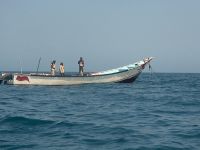Pakistan is a significant energy consumer and an important country in South Asian security, especially in light of its nuclear tests in 1998. Opportunities exist for foreign direct investment in Pakistan's energy sector, though some foreign investors have encountered problems in recent years. Note: information contained in this report is the best available as of February 2001 and can change.
General Background:
Recent economic developments in Pakistan have been dominated by the country's decision to undertake a series of nuclear weapons tests in late May 1998, and the military coup which brought General Pervaiz Musharraf to power in October 1999.
The nuclear tests followed an announcement by regional rival India of its own tests earlier in the month. As required by law, the United States imposed sanctions against Pakistan, in addition to those which had already been in effect since 1990 mandated by the Pressler Amendment.
By far the most significant sanctions were the suspension of U.S. government credits and guarantees (such as Eximbank loans and OPIC risk insurance) and U.S. opposition to further loans from International Financial Institutions (IFI's).
Suspension of Japan's foreign aid program for Pakistan also had a sizable impact. Pakistan responded to these actions with a freeze on most foreign currency transactions.
In October 1998, after both India and Pakistan had declared moratoriums on nuclear testing, the U.S. Congress passed a bill providing the President the authority to waive some of the sanctions measures for a period of one year.
In November 1998, the most significant sanctions dealing with OPIC and Eximbank activities, as well as mandatory U.S. opposition to further loans to Pakistan from international financial institutions, were suspended. In October 1999, President Clinton acted to extend the waiver of sanctions.
Pakistan's real gross domestic product (GDP) growth rate fell to 1.8 percent in 2000, from a high of 4.7 percent in 1998, and is projected to rise to only 2.3 percent in 2001.
Inflation is projected to fall to 11.1 percent in 2001 from a high of 15.6 percent in 2000. Pakistan's external debt is equal to more than half of its annual GDP, and its debt payments due each year exceed its receipts from exports.
Population growth is currently running at 2.8 percent per year. The government also suffers from a relatively ineffective system for tax collection, with only 1% of the population paying income taxes.
While formal legal protections for foreign investment in Pakistan generally are good, inadequate infrastructure, a poorly educated workforce, sectarian and ethnic violence, and a slow-moving judicial system have proven to be obstacles to attracting foreign investment.
While some of the well-publicized disputes between Pakistani state entities and the country's Independent Power Producers (IPP's) have been resolved, the dispute has been a major blow to foreign investor confidence in Pakistan.
Foreign Direct Investment (FDI) in Pakistan for 2000 was only a small fraction of the comparable figures for the mid-1990s.
The International Monetary Fund concluded a standby loan agreement with Pakistan in November 2000, which will provide $596 million over the following ten months, allowing Pakistan to avoid default on its foreign debt.
Pakistan also is currently in discussions with the Paris Club of creditor nations on the issue of a broader rescheduling of its debt.
Oil:
Pakistan produced 57,000 barrels per day (bbl/d) of crude oil in 1999, and consumed 350,000 bbl/d, requiring net oil imports of about 293,000 bbl/d.
While there is no prospect for Pakistan to reach self sufficiency in oil, the government has encouraged private (including foreign) firms to develop domestic production capacity.
Pakistani domestic production centers on the Potwar Plateau in Punjab and lower Sindh province. Most of the foreign firms active in Pakistan in the oil exploration and production sector are small independent firms. The two most significant foreign oil firms in Pakistan are BP Amoco and British independent Lasmo Oil.
State owned Oil and Gas Development Corporation (OGDC) also is a major player.Malaysia's Petronas has acquired a stake in an exploration block in Sindh province, in cooperation with Lasmo Oil.
In November 2000, the Pakistani government awarded two exploration blocks: the onshore Mehran Block 2467-4 to a team including Union Texas Pakistan, a subsidiary of BP Amoco, and Occidental Petroleum, and an offshore block to Ocean Energy.
American independent Orient Petroleum, which also hold concessions in Pakistan, is investing approximately $70 million in seismic surveys and exploratory drilling over an initial period of three years.
Recent exploration activity has yielded several minor new discoveries. The most significant in 2000 was the Pariwali-3 well on the Potwar Plateau, which is expected to produce 2,500 bbl/d once it is developed.
Refining/Downstream:
Pakistan's net oil imports are projected to rise substantially in coming years as demand growth outpaces increases in production.
Demand for refined petroleum products also greatly exceeds domestic refining capacity, so nearly half of its imports are refined products.
Pakistan's Pak-Arab Refinery (PARCO) became operational in late 2000, adding 100,000 bbl/d to the country's refining capacity, and alleviating refined product import dependence.
Another major planned project is the "Iran-Pak" refinery, which would have a capacity of 130,000 bbl/d. The refinery would be located near the border with Iran in Baluchistan and would be a 50:50 partnership between Pakistan's Petroleum Refining and Petrochemical Corporation (PERAC) and the National Iranian Oil Company (NIOC).
Oil processed at the Iran-Pak refinery would come almost exclusively by sea from Iran, and would be unloaded at a terminal to be built for the refinery.
The project has not reached financial closure, but negotiations are continuing. A smaller 30,000 bbl/d project planned for Badin was cancelled in 1999 due to inability to reach financial close.
In the fuel and lubricant distribution sector, the government of Pakistan plans to privatize the Pakistan State Oil (PSO) company, which holds three-quarters of the market share for petroleum products distribution and has more than 3,000 outlets.
Deregulation of prices for petroleum products is being pursued in parallel with the privatization of PSO.
As part of the privatization process, the government of Pakistan is setting up the Gas Regulatory Authority (GRA) and the Petroleum Regulatory Board (PRB), which will separate out the government functions from the state owned companies to be privatized.
Pakistan's government hopes to reap significant revenues from these privatizations over the next several years.
Natural Gas: Pakistan has 21.6 trillion cubic feet (Tcf) of proven gas reserves, and currently produces nearly 0.8 Tcf of natural gas per year, all of which is consumed domestically.
Natural gas producers include Pakistani state-owned companies Pakistan Petroleum Ltd. (PPL) and Oil and Gas Development Corporation (OGDC), as well as Atlantic Richfield, Lasmo Oil, OMV, and BHP.
The largest currently productive fields are Sui, with 650 million cubic feet per day (Mmcfd), Adhi and Kandkhot (120 Mmcfd), Mari, and Kandanwari.
Pakistan's demand for natural gas is expected to rise substantially in the next few years, with an increase of roughly 50 percent by 2006, according to Pakistan's oil and gas ministry.
Pakistan also plans to make gas the "fuel of choice" for future electric power generation projects. This will necessitate a sharp rise in production of natural gas, and also has generated interest in Pakistan in pipelines to facilitate imports from neighboring countries.
Much of Pakistan's increased gas demand will be satisfied by increased domestic production.
Austrian company OMV's 1998 discovery at Sawan is expected to produce 450 Mmcfd by 2001. Lasmo reported a new find in March 1999, in western Sindh province, which is expected to produce 20 Mmcfd.
Hardy Oil (UK) also reported a new discovery in 1999, in the Middle Indus region of Sindh, which tested at an initial 58 Mmcfd.
Recent offshore exploration concessions have also been granted to Lasmo, Shell, OMV, and others. Development of new gas fields is proceeding, and Pakistan's government expects recently discovered gas fields to add about 1 billion cubic feet per day (Bcf/d) to Pakistan's gas production.
The Zamzama gas field in Sindh province is due to come onstream in March 2001, and is expected to produce 60 Mmcfd.
The Sawan gas field, being developed by a consortium heeaded by Austrian OMV, is set to begin deliveries in 2002 and to reach peak production of 170 Mmcfd.
Pakistan recently signed a contract with Lasmo oil for the development of the Bhit gas field, which is expected to come onstream in 2002 and reach peak production of 235 Mmcfd by 2003.
Several import schemes also have been under discussion in recent years. In mid-2000, Pakistan's government stated that it would permit a gas pipeline linking Iran's massive gas reserves to rival India to cross its territory.
Pakistan would earn transit fees for Iranian gas supplied to India and also be able to purchase gas from the pipeline itself.
While Iran and Pakistan have shown great interest in the project, India has been reluctant to move forward as long as political and military tensions with Pakistan over Kashmir persist.
Another possibility is that Pakistan could eventually be linked into the Dolphin Project, a scheme to supply gas from Qatar's North Dome gasfield to the United Arab Emirates and Oman, via a subsea pipeline from Oman.
Even though Pakistan has signed a preliminary agreement to eventually purchase gas from Qatar, it seems increasingly unlikely that Pakistan will be included in the project in the near-term, due to it financial weakness and uncertainty about whether there will be sufficient demand growth.
A third possible gas pipeline would link gas-rich Turkmenistan with Dalautabad in central Pakistan via Afghanistan. Unocal had been the main foreign backer of the plan until August 1998, when it withdrew from the project after the U.S. strikes against terrorist training camps associated with Osama bin Laden in Afghanistan.
Since then, the governments of Pakistan and Turkmenistan have been holding talks with the Afghan Taliban authorities about continuing the project without Unocal, but it appears unlikely that the project will be implemented.
Some independent observers of the Pakistani gas market believe that increases in domestic gas production, coupled with a slower growth in demand than projected by the Pakistani government, will render the gas pipeline projects economically inviable.
In addition, Pakistan's weak financial position makes it difficult to secure financing for such ambitious projects.
A pipeline from Iran to India would make more sense in financial terms, as its primary justification would be sales to India, with Pakistan as only a secondary customer, but the energy security issues it raises for India make it unlikely to proceed.
Source: United States Energy Information Administration.
© 2001 Mena Report (www.menareport.com)







